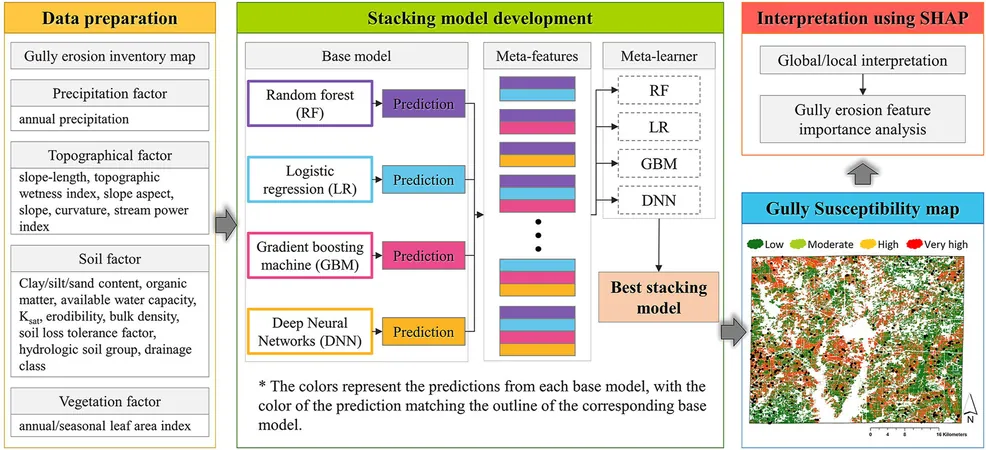
Revolutionizing Gully Erosion Predictions with Groundbreaking AI Techniques
2025-05-21
Author: Mei
Gully Erosion: A Silent Predator of Agricultural Land
Gully erosion strikes at the heart of agricultural productivity, swiftly transforming fertile fields into barren landscapes. This most severe form of soil erosion not only leads to significant sediment loss but also disastrous nutrient runoff into our precious waterways. Triggered by just one heavy rainfall, gullies can emerge out of nowhere, forming deep channels that pose a substantial challenge to rehabilitation efforts—even with heavy machinery involved.
A Game-Changer: AI in Erosion Prediction
Researchers from the University of Illinois Urbana-Champaign have introduced a cutting-edge AI approach that fuses machine learning with advanced interpretability tools. This innovative methodology aims to significantly boost the accuracy of gully erosion predictions and enhance our comprehension of these models. Their experimental research focuses on the agricultural landscapes of Jefferson County, Illinois.
From Baseline to Breakthrough: Evolving Prediction Techniques
In earlier studies, the team relied on a singular machine learning model, which, while valuable, offered limited predictive accuracy and lacked clarity on its decision-making mechanism. If agricultural producers and land managers can identify where erosion is likely to occur, they can craft targeted conservation strategies to protect their lands. "This research addresses critical limitations in previous models," says lead author Jeongho Han.
Understanding Jefferson County's Unique Landscape
Situated in the Big Muddy River watershed and characterized by rolling hills, Jefferson County primarily serves as fertile ground for corn and soybean farming. The research team constructed gully erosion inventory maps by analyzing elevation data from 2012 and 2015. They identified a staggering 25 environmental factors that sway erosion susceptibility—including topography, soil compositions, and precipitation patterns.
Harnessing the Power of Stacked Models
Weathering the complexities of environmental processes such as terrain, soil, and hydrology makes predicting gully erosion particularly troublesome. While machine learning models are frequently applied in erosion prediction, their performance can vary widely. By stacking multiple predictive models, the researchers employed a unique strategy that not only improved accuracy but also evaluated the synergy between different models.
Unveiling Insights with Explainable AI
By creating precision gully erosion susceptibility maps using their top-performing model, the researchers achieved an impressive prediction accuracy of 91.6%—a notable leap from 86% with the best individual model. To clarify the often opaque nature of AI outputs, they incorporated SHapley Additive exPlanations (SHAP), a tool designed to interpret complex AI models and explain how specific variables impact predictions.
Key Findings: Crop Coverage Matters!
Their findings underscored the importance of the annual leaf area index of crops, identified as the most critical factor across models. Higher leaf coverage significantly mitigates the force of rain on soil, thus reducing erosion severity.
A New Era for Agricultural Management
This innovative framework empowers farmers and land managers, enabling them to discern which areas are most vulnerable to erosion and what measures are necessary for intervention. By clarifying model outputs and decision-making processes, this approach could reshape environmental management and policy, paving the way for more responsible resource allocation. As highlighted in their research, this model is not just a tool—it's a transformative strategy for sustainable agriculture.



 Brasil (PT)
Brasil (PT)
 Canada (EN)
Canada (EN)
 Chile (ES)
Chile (ES)
 Česko (CS)
Česko (CS)
 대한민국 (KO)
대한민국 (KO)
 España (ES)
España (ES)
 France (FR)
France (FR)
 Hong Kong (EN)
Hong Kong (EN)
 Italia (IT)
Italia (IT)
 日本 (JA)
日本 (JA)
 Magyarország (HU)
Magyarország (HU)
 Norge (NO)
Norge (NO)
 Polska (PL)
Polska (PL)
 Schweiz (DE)
Schweiz (DE)
 Singapore (EN)
Singapore (EN)
 Sverige (SV)
Sverige (SV)
 Suomi (FI)
Suomi (FI)
 Türkiye (TR)
Türkiye (TR)
 الإمارات العربية المتحدة (AR)
الإمارات العربية المتحدة (AR)